Abstract
Running is associated with a higher risk of overuse injury than other forms of aerobic exercise such as walking, swimming and cycling. An accurate description of the proportion of running injuries per anatomical location and where possible, per specific pathology, for both genders is required. The aim of this review was to determine the proportion of lower limb running injuries by anatomical location and by specific pathology in male and female runners (≥800m - ≤ marathon). The preferred reporting items for systematic reviews and meta-analyses guidelines were followed for this review. A literature search was performed with no restriction on publication year in Web of Science, Scopus, Sport-Discus, PubMed, and CINAHL up to July 2017. Retrospective, cross-sectional, prospective and randomised-controlled studies which surveyed injury data in runners were included. 36 studies were included to report the overall proportion of injury per anatomical location. The overall proportion of injury by specific pathology was reported from 11 studies. The knee (28%), ankle-foot (26%) and shank (16%) accounted for the highest proportion of injury in male and female runners, although the proportion of knee injury was greater in women (40% vs. 31%). Relative to women, men had a greater proportion of ankle-foot (26% vs. 19%) and shank (21% vs. 16%) injuries. Patellofemoral pain syndrome (PFPS; 17%), Achilles tendinopathy (AT; 10%) and medial tibial stress syndrome (MTS; 8%) accounted for the highest proportion of specific pathologies recorded overall. There was insufficient data to sub-divide specific pathology between genders. The predominate injury in female runners is to the knee. Male runners have a more even distribution of injury between the knee, shank and ankle-foot complex. There are several methodological issues, which limit the interpretation of epidemiological data in running injury.
Key points.
The highest proportion of running injury occurs from the knee downwards.
The top 3 anatomical locations for running injuries are common to both genders but women seem to suffer more knee injuries relative to men.
Injuries reported using medical diagnosis appear to mirror the anatomical locations most commonly injured.
Greater standardisation of injury audit tools are required in order to be able to perform meta-analysis on the prevalence and incidence of injury in runners.
Key words: Running, injury, injury prevention, epidemiology
Introduction
Running is associated with a higher risk of overuse injury (Bertola et al., 2014; Hauret et al., 2015; Salmon et al., 2014) than other forms of aerobic exercise such as walking, swimming and cycling. To unlock the full potential of running as a sport or a vehicle to improve health there is a need to understand the aetiology of injury. In any sport, this process begins by gaining an understanding of the most frequent injuries associated with that sport (Fitzharris et al., 2017).
Preferably, injury epidemiology would be synthesized from high quality studies, using standardised definitions, by way of systematic review and meta-analysis. This poses a challenge to researchers due to the heterogeneity of studies in the literature, which are affected by differences in study populations, designs and injury or exposure definitions. The most recent systematic reviews on running injury (Kluitenberg et al., 2015; Lopes et al., 2012; Nielsen et al., 2012; van der Worp et al., 2015; Videbaek et al., 2015) have highlighted issues such as a lack of standardised injury definitions, the classification of a runner, and the recording of exposure. To minimise the effect of study heterogeneity on the outcome variable of interest, authors of systematic reviews have used strict inclusion-exclusion criteria to answer specific questions about running injury epidemiology or injury epidemiology in specific types of runners. This results in a smaller number of studies being included for review. Reviews that focus on injury incidence require accurate estimates of exposure (van der Worp et al., 2015; Videbaek et al., 2015). Reviews that focus on the prevalence of specific injuries or injuries in a specific population of runners, are limited to those studies including a medical diagnosis or specific type of runner (Kluitenberg et al., 2015; Lopes et al., 2012).
An alternative approach, albeit less sensitive and potentially subject to greater bias, is to use a broad inclusion criteria. This would allow inclusion of a larger population (i.e. recreational, amateur, elite, triathlon, orienteering), and a broader classification of injury (i.e. hip, knee, ankle and foot). Subsequently, sub-group analyses can be performed from studies that clearly describe injury per gender or specific pathology. Gaining a broad understanding of the proportion of running injuries could provide a foundation for the investigation of risk factors associated with running injuries. Furthermore, knowledge of the anatomical locations most commonly affected may assist with the development of standardised study procedures in relation to reporting injury prevalence and incidence. A number of running injury epidemiology studies have recently been published (Altman and Davis, 2016; Hespanhol Junior et al., 2016; Hespanhol Junior et al., 2017b; Kerr et al., 2016; Malisoux et al., 2016b; Smits et al., 2016; van der Worp et al., 2016), therefore the primary aim of this review was to determine the proportion of injuries in male and female runners by anatomical site. A secondary aim was to specify pathologies (self-reported or reported by a health care practitioner), where possible.
Methods
Data sources and search strategy
This review was prepared and conducted according to the preferred reporting items for systematic reviews and meta-analysis (PRISMA) guidelines (Moher et al., 2009). The aim of the search strategy was to find published retrospective, cross-sectional, prospective and randomised-controlled studies that provided survey data. The following electronic databases were searched (from inception) without date restriction to July 2017; and included Web of Science (n = 194), Scopus (n = 215), SportDiscus (n = 72), PubMed (n = 691), SCIELO (n = 5) and CINAHL (n = 57). The last electronic search was conducted on 01/07/2018. Search terms included running* (Boolean Phrase); injury* (Boolean Phrase); prevalence* (Boolean Phrase). In addition, manual searches of the reference lists of four recent running injury systematic reviews (Kluitenberg et al., 2015; Lopes et al., 2012; van der Worp et al., 2015; Videbaek et al., 2015) were undertaken by a single author (PF). All citations were imported to EndNote X7 (Thomson Reuters, USA) and duplicates removed by PF. Articles were screened by title, abstract and finally full text, according to predetermined study criteria (Figure 1). Three authors (PF, CW and KS) independently reviewed all titles and abstracts, and selected those for inclusion. Disagreement was resolved via consensus and a third author (MIJ) was to be consulted if no agreement was reached. Full texts were reviewed by one author (PF) to determine which studies met the inclusion criteria. No hand-search of specific sports medicine journals was performed.
Figure 1.
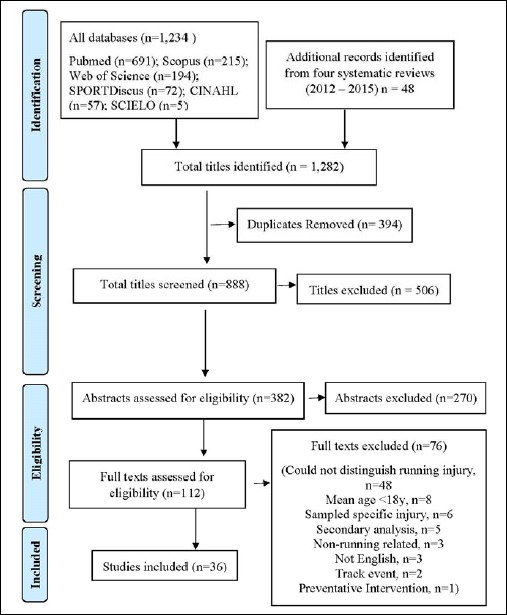
Flow chart of literature search.
Inclusion and exclusion criteria
The inclusion criteria were: (1) published peer-reviewed prospective cohort; retrospective cohort; cross-sectional; or randomised controlled studies, (2) reported running injury data in adult (mean age: ≥18 years) runners, (novice, recreational, amateur, elite runners, triathletes and orienteers) competing in distances ≥800m - ≤ marathon), (3) provided the anatomical location of lower limb running injury separate to other injuries/illness (e.g. upper body), (4) written in English, (5) interventions that did not alter the volume of running undertaken, use strategies designed to directly alter pain, and did not report a difference in running related injury (RRI) between intervention and control groups (e.g. the influence of footwear on running injury), (6) included shod injuries separate to barefoot injuries in studies investigating these conditions, (7) not duplicate publications or multiple studies on the same cohort, (8) did not include service personnel (e.g. police, fire service, military) (9) separated lower limb running injuries from other lower limb injuries (e.g. triathlon injuries divided into swim, bike and running), (10) did not recruit participants with a specific type of injury, (11) did not describe track and field competition injuries, (12) presented data as running injury or any lower limb pain regardless of its interference with running.
Data extraction
Data from included studies were extracted by a single author (PF), and checked by MIJ. A standardised data extraction sheet was developed by PF (available on request) where the following data related to study characteristics and injury were extracted: (1) author, year, (2) runner type, (3) gender, age, (4) injury definition, yes/no, (5) study design, (6) time period for retrospective/prospective analysis (7) gender split of injuries, yes/no, (8) sampling method, (9) 6-month or 12-month follow up for prospective or retrospective studies respectively, yes/no, (10) the sample included versus analysed, (11) injury as self-reported, reported by a health professional or diagnosed by a medical doctor (12) injury proportion expressed as a total of all injury, yes/no, (13) consistent mode of data collection, yes/no, (14) all injuries reported, yes/no, (15) running injuries separate, yes/no, (16) anatomical location or specific injury identifiable, yes/no, (17) number of runners, number of injured runners, total injuries, (18) anatomical location of injury, (19) specific type of injury. The primary outcome variable was the proportion of lower limb running injury. Due to the heterogeneity of studies, studies were grouped according to anatomical location, and subsequent sub-group analyses were conducted on data pertaining to specific pathologies. Injuries were categorized by the anatomical regions ‘hip’ (hip joint/pelvis/groin), ‘thigh’ (upper leg), ‘knee’, ‘shank’ (lower leg), ‘ankle-foot’ (including toes) and ‘other’ (not clear diagnosis/location/upper extremity/illness)(Kluitenberg et al., 2015; van Gent et al., 2007). Overall injury prevalence was defined as the number of injured runners divided by the total number of runners in the study. This was calculated from 26-studies where injured runners could be separated from the total number of runners and the total number of running injuries. Descriptive statistics for prevalence were calculated using SPSS. Injury proportions were defined as the total injury number per anatomical region or specific pathology divided by the total number of injuries reported from all sites or pathologies. Specific pathology refers to a pathology with a self-reported or confirmed medical diagnosis.
Quality assessment
Recent systematic reviews on running injury prevalence, incidence and risk factors have used different tools to assess the quality of studies (Lopes et al., 2012; Nielsen et al., 2012; van der Worp et al., 2015; Videbaek et al., 2015). Most tools that have been used can be traced back to epidemiological or occupational studies on general musculoskeletal pain (van der Worp et al., 2015). The tool is often modified to be more ‘running’ specific and subsequent running reviews often modify it further (Nielsen et al., 2012; Videbaek et al., 2015) or propose their own criteria based on the aims of their review (Lopes et al., 2012). A score out of the total number of criteria or a percentage of positive responses (from yes-no answers) are used to express quality (Kluitenberg et al., 2015; Nielsen et al., 2012; van der Worp et al., 2015).
The main purpose of this study was to determine the proportion of injuries at different anatomical locations in runners and where possible specify the pathology responsible. The level of runner, cause, prevalence or incidence of injury were not of interest thus minimising the importance of methods for randomization for the quality of outcome. Therefore, we used the 10 yes/no criteria proposed by Lopes et al. (2012) as their review was mainly concerned with prevalence and also because the 10 criteria also encapsulated 7 of the 8 criteria recently used by Videbaek et al. (2015) to conduct a similar review. The only difference between our quality assessment and that reported by Lopes et al. (2012) is that where the authors used the words prevalence or incidence, we used the word proportion. Using yes/no criteria a positive score ≥50% is deemed a low risk of bias (Kluitenberg et al., 2015; van der Worp et al., 2015). The detailed criteria can be viewed within the supplementary material from the authors’ (Lopes et al. 2012) manuscript but briefly they are as follows: 1) definition of injury reported, yes/no; 2) studies with prospective and cross-sectional designs that present proportion data, yes/no; 3) description of the population or type of runner e.g. 10km, marathon, yes/no; 4) random sampling used (i.e. not a convenience sample), yes/no; 5) data analysis performed on 80% of the participants, yes/no; 6) self-reported injury by the athlete or health care professional, yes/no; 7) consistent mode of data collection, yes/no; 8) diagnosis by a medical doctor, yes/no; 9) a follow-up of 6 months for prospective trials or up to 12-months for retrospective trials, yes/no; 10) injury proportion expressed as a proportion of total injuries, yes/no.
Results
Characteristics of included studies
The literature search yielded 1282 unique citations, of which 112 full texts were obtained and assessed for eligibility. Of the 112 full-text articles, 36 met the eligibility criteria and progressed to data extraction. The reasons for the exclusion of specific studies are displayed in the study flow chart (Figure 1). Of the 36 included studies, 18 were prospective injury audits, 16 were retrospective injury audits, and two were a cross-sectional analyses of current injuries.
Quantitative analysis
Injury proportions by anatomical location were calculated from 10,688 injuries reported from 18,195 runners included in the 36 studies. These proportions were further sub-categorised for females (n = 8 studies, 2,279 injuries) and males (n = 7 studies, 1,875 injuries). Overall injury proportions for specific pathologies were calculated from 3,580 injuries reported by 4,752 runners (n = 11 studies). There were insufficient data (n = 2 studies) to divide specific pathologies by gender. The overall injury prevalence, calculated from 13,182 runners reporting 5,362 injuries (n = 26 studies), was 42.7% ± 19.8 (range 10 – 92%; 95% confidence interval 34.7% - 50.7%).
Injury proportions by anatomical site
Figure 2 displays the proportion of injuries by anatomical location. The knee (28%) and ankle-foot (26%) regions accounted for over half of all the injuries reported (n = 5,816/10,688). The third highest proportion of injury was at the shank (16%). These data indicate that 70% of all injuries reported were at or below the knee. The hip and thigh regions accounted for 14% of injuries. The remaining injuries (other, 15%) were either of unclear location, from the upper extremity, or illness.
Figure 2.
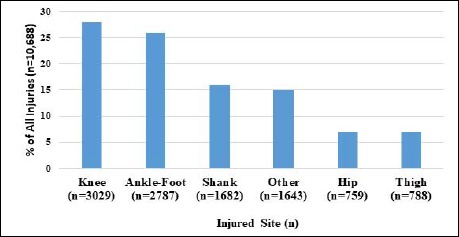
Injury proportions by anatomical site (%).
The proportion of injury per anatomical location did not change when analysed by gender. Injuries to the knee and below accounted for the majority of injuries in men (78%) and women (75%). However, the proportions of the three most frequent injuries differ between genders (Figure 3 and 4). Figure 4 illustrates that knee injuries account for 40% of all injuries in women, followed by the ankle-foot (19%) and shank (16%). Injuries are more evenly weighted in men between knee (31%), ankle-foot (26%) and shank (21%) (Figure 3).
Figure 3.
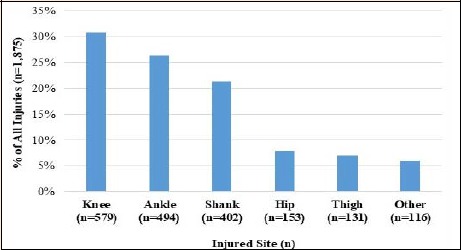
Male injury proportions by anatomical site (%).
Figure 4.
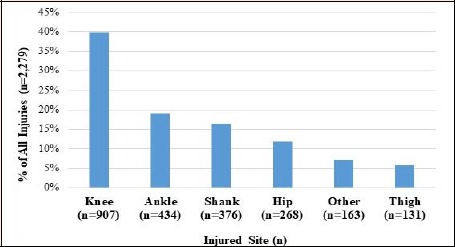
Female injury proportions by anatomical site (%).
The hip and thigh regions accounted for 15% and 18% of all injuries in men and women respectively. Injuries classified as ‘other’ accounted for 6% and 7% of all injuries in men and women respectively.
Injury proportions by specific pathology
From the 3,580 recorded injuries, 770 were classified as ‘other’. The top 10 running injuries recorded from the remaining 2,810 injuries are displayed in Figure 5 and expressed as a percentage of all injuries (n = 3,580).
Figure 5.
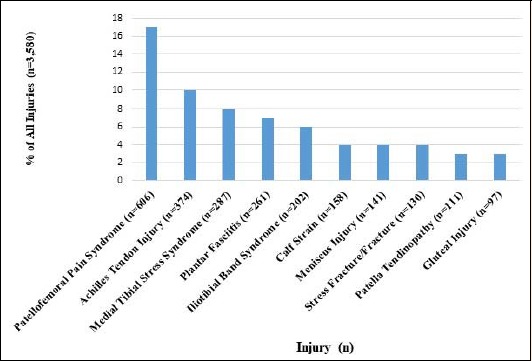
Top 10 injury proportions by specific pathology (%).
Discussion
The purpose of this review, was to describe the proportion of running injuries by anatomical location and where possible, specific pathology in men and women. There was sufficient literature to satisfy this aim in relation to anatomical location and specific pathology for both genders combined but only the anatomical location of injury could be divided by gender.
The proportion of running injuries by anatomical site and specific pathology
Unsurprisingly, and in agreement with previous reviews on the topic, the majority (~70%) of running injuries occur at or below the knee (Kluitenberg et al., 2015; Lopes et al., 2012). This finding is true for both men and women.
The top 10 running injuries, identifiable by specific pathology, support this finding. However, although the most commonly injured sites in men and women are the same, the proportions for each site differ. The main difference is that women have a larger proportion of knee injuries (40% of all injuries), relative to men, who experience a similar proportion of knee (31%) and ankle-foot (26%) injuries. This difference may be due to structural differences between males and females, or functional differences in running biomechanics. For example, it is well established that females have a higher incidence of traumatic knee injury in football and basketball relative to their male counterparts (Arendt and Dick, 1995). This has been suggested to be due to altered neuromuscular control in females arising from a greater Q-angle and a greater reliance on quadriceps muscle activity to control landing using more upright postures (Sigward and Powers, 2006). These gender differences will have had an impact on the data we report for specific pathologies. The two most common running injuries were patellofemoral pain syndrome (PFPS) and Achilles tendinopathy (AT), which is in agreement with previous reports on the prevalence of musculoskeletal injury in runners (Junior et al., 2011; Lopes et al., 2012). The proportion of PFPS is far in excess of AT (17% (n = 606) vs. 10% (n = 374)) and may reflect a gender bias due to women having more knee injuries. Equally, men have a greater proportion of ankle-foot injuries relative to women (26% (n = 494) vs. 19% (n = 434)) which may indicate that the proportion of AT injuries is male biased. This suggestion is supported somewhat by the only two studies included which differentiated gender when reporting specific pathologies (Nielsen et al., 2014; Taunton et al., 2002). Taunton et al. (2002) report gender differences in the proportion of PFPS, AT and plantar fasciitis (PF) reported from an analysis of injuries (n = 2002) obtained from patient records at a sports medicine centre. Women had more PFPS than men and less AT and PF. In a smaller sample of injuries (n = 254) obtained prospectively, the proportion of PFPS appears to be greater in women and the proportion of AT and PF divided equally between genders. The proportion of specific pathologies will also be influenced by the variability in time to recover from different running injuries and the likelihood of reoccurrence (Nielsen et al., 2014).
Methodological issues with the collation and reporting of running injury data
Although not an aim of the present review, we were able to report the overall prevalence of injury in runners from 26-studies. The overall prevalence of injury (42.7%) varied greatly (10 – 92%) and is in agreement with estimates previously reported (van der Worp et al., 2015; van Gent et al., 2007). The extraction of data highlighted the difficulty in reporting accurate estimates of the proportion, prevalence and incidence of running injury from existing literature. We came across many of the issues reported by previous systematic reviews, such as a lack of consistency in defining a runner, an injury, and exposure. Additionally and most notably, we observed a lack of clarity and consistency amongst studies reporting a) the total number of runners, b) the total number of injured runners c) the total number of injuries, and d) the number of new injuries versus recurrent injuries.
Although many of the studies included in our review scored well in terms of quality assessment (Table 2), it is perhaps more informative to have a qualitative discussion of the issues highlighted by Table 1 and 2. This review raises some important considerations for the design and implementation of future retrospective, cross-sectional or prospective injury studies. The first consideration is in relation to the definition of a runner. Systematic reviews have reported differences in running injuries between various levels (novice, recreational, amateur, competitive, elite) of runners but perhaps with the exception of elite (professional) and beginner (e.g. Netherlands Start to Run Programme) these definitions lack objective data to support their validity. An estimate of the volume (minutes or distance) and intensity (rate of perceived exertion) of running would allow for an accurate description of runner ‘level’ in studies. The definition of injury poses a challenge toward comparing research findings not just due to the heterogeneity of definitions used, but because the link between pain and injury is not as clear in sports where chronic injury predominates. If a study uses a time loss definition of injury, such as that used in football (Jones et al., 2018), it does not capture sub-clinical pathology which interferes with but does not prevent running. Recently data has been published demonstrating insidious pathology, which rugby players perceive to interfere with performance even though they are classified as uninjured (Partner and Francis, 2018). If a study used a definition of symptoms regardless of its interference with running, it may capture data from high functioning runners who would not be considered injured in the traditional sense. Whether these symptoms are predictive of future risk of injury is unknown. It would seem pertinent for running injury audits to begin to collect data in relation to pain and time-loss injuries in runners. This would begin to shed light on the burden of pain and injury in running.
Table 2.
Quality assessment of included studies
| Study, year | ID | PDt | PDs | SPoT | An | SR | MDC | MDD | FuP | PT | Score |
|---|---|---|---|---|---|---|---|---|---|---|---|
| Maughan and Miller (1983)c,d | N | Y | Y | Y | Y | Y | Y | N | Y | Y | 8/10 |
| Linde (1986)c | Y | Y | Y | Y | Y | Y | Y | N | Y | Y | 9/10 |
| Collins et al. (1989)c | Y | Y | Y | N | Y | Y | Y | N | na | Y | 7/9 |
| van Mechelen et al. (1993)b | Y | Y | N | Y | N | Y | Y | N | N | Y | 6/10 |
| Jakobsen et al. (1994)c,d | Y | Y | Y | N | Y | Y | Y | N | Y | Y | 8/10 |
| Wen et al. (1998)d | Y | Y | Y | N | Y | Y | Y | N | Y | Y | 8/10 |
| Williams et al. (2001) | N | Y | Y | N | Y | Y | Y | N | na | Y | 6/9 |
| Chorley et al. (2002)d | Y | Y | N | N | Y | Y | Y | Y | N | Y | 7/10 |
| Taunton et al. (2003)a,b | Y | Y | N | N | Y | Y | Y | N | N | Y | 6/10 |
| Taunton et al. (2002)a,b,c | Y | Y | N | N | Y | N | Y | Y | N | Y | 6/10 |
| Lun et al. (2004)d | Y | Y | N | N | N | Y | Y | N | na | Y | 5/9 |
| McKean et al. (2006)d | Y | Y | N | N | Y | Y | Y | Y | na | Y | 7/9 |
| Van Middelkoop et al. (2008)b,d | Y | Y | Y | Y | Y | Y | Y | N | Y | Y | 9/10 |
| Knobloch et al. (2008)c | Y | Y | Y | N | Y | Y | Y | N | na | Y | 7/9 |
| Van Ginckel et al. (2009) | Y | Y | Y | N | Y | Y | Y | N | N | Y | 7/10 |
| Ryan et al. (2011)a,d | Y | Y | Y | N | N | Y | Y | N | N | Y | 6/10 |
| Lopes et al. (2011)a,b,d | Y | Y | Y | Y | Y | Y | Y | N | na | Y | 8/9 |
| Bredeweg et al. (2012) | Y | Y | Y | N | Y | Y | Y | N | N | Y | 7/10 |
| Chang et al. (2012)d | N | Y | Y | N | Y | Y | Y | N | na | Y | 6/9 |
| Hespanhol Junior et al. (2012)c,d | Y | Y | Y | N | Y | Y | Y | N | Y | Y | 8/10 |
| Vadeboncoeur et al. (2012)a,d | Y | Y | Y | N | N | Y | Y | N | N | Y | 6/10 |
| Hendricks and Phillips (2013)d | Y | Y | Y | N | Y | Y | Y | N | N | Y | 7/10 |
| Rasmussen et al. (2013)d | Y | Y | Y | Y | Y | Y | Y | N | Y | Y | 9/10 |
| Hespanhol Junior et al. (2013)d | Y | Y | Y | N | Y | Y | Y | N | N | Y | 7/10 |
| Ogwumike and Adeniyi (2013)d | N | Y | Y | Y | Y | N | Y | Y | na | Y | 7/9 |
| Nielsen et al. (2014)a,b,c,d | Y | Y | Y | Y | Y | N | Y | Y | Y | Y | 9/10 |
| Theisen et al. (2014)d | Y | Y | Y | N | Y | Y | Y | N | N | Y | 7/10 |
| Malisoux et al. (2015)d | Y | Y | Y | N | N | Y | Y | N | N | Y | 6/10 |
| Altman and Davis (2016)c | N | Y | Y | Y | Y | Y | Y | N | Y | Y | 8/10 |
| Kerr et al. (2016)a,b | Y | Y | Y | N | Y | Y | Y | N | N | Y | 7/10 |
| Teixeira et al. (2016)d | Y | Y | Y | Y | Y | Y | Y | N | Y | Y | 9/10 |
| van der Worp et al. (2016)a,d | Y | Y | Y | Y | Y | Y | Y | N | N | Y | 8/10 |
| Hespanhol Junior et al. (2016)c,d | Y | Y | Y | N | Y | Y | Y | N | N | Y | 7/10 |
| Malisoux et al. (2016a)d | Y | Y | Y | N | Y | Y | Y | N | Y | Y | 8/10 |
| Smits et al. (2016) | Y | Y | Y | Y | N | Y | Y | N | N | Y | 7/10 |
| Hespanhol Junior et al. (2017a)c,d | Y | Y | Y | N | Y | Y | Y | N | Y | Y | 8/10 |
ID = Injury Definition; PDt = Proportion Data; PDs = Population Description; SPoT = Sampling Population or Target; An = Analysis (≥80% of sample); SR = Self-Reported; MDC = Mode Data Collection; MDD = Medical Doctor Diagnosis; FuP = Follow-up Period; PT = Proportion of Total; Y= yes, N= no, na = not applicable.
a, b, c, d = as per Table 1.
Table 1.
Characteristics of included studies.
| Study, year | Study design | Population | Time Period | Anatomical Injury Location | Identifiable Pathologies | Gender Split | Total Runners | Total Injured Runners | Total Injuries |
|---|---|---|---|---|---|---|---|---|---|
| Maughan and Miller (1983)c,d | Retrospective Injury Questionnaire |
Marathon M & F (32 ± 8 y ) |
6 months |
Y | N | N | 497 | 287 | 358 |
| Linde (1986)c | Prospective Injury Questionnaire |
Orienteers M & F (19 – 34 y) |
1 year |
Y | N | N | 42 | _* | 73 |
| Collins et al. (1989)c | Retrospective Injury Questionnaire |
Triathlon M & F (mean age: 32 y) |
1 year |
Y | S | N | 257 | _* | 105 |
| van Mechelen et al. (1993)b | RCT (Prospective Questionnaire) |
Recreational M (adults) |
16 weeks |
Y | N | MO | 327 | _* | 49 |
| Jakobsen et al. (1994)c,d | Prospective Controlled Trial (Prospective Questionnaire) | Recreational M & F (24 – 56 y) |
1 year |
Y | S | N | 20 | 13 | 21 |
| Wen et al. (1998)d | Cross-Sectional Associative Study (Retrospective Questionnaire) |
Experienced / Marathon Runners M & F (20 – 78 y) |
1 year |
Y | N | N | 304 | 136 | 217 |
| Williams et al. (2001) | Cross-Sectional Associative Study (Retrospective Questionnaire) |
Amateur M & F (18 – 50 y) |
_ | Y | N | N | 40 | _* | 134 |
| Chorley et al. (2002)d | Retrospective Injury Questionnaire |
Novice & Amateur M & F (mean age: 34 y) |
3 years |
Y | N | N | 1548 | 590 | 977 |
| Taunton et al. (2003)a,b | Prospective Injury Questionnaire |
Recreational M & F (<30 - >56y) |
13 weeks |
Y | N | Y | 840 | 249 | _* |
| Taunton et al. (2002)a,b,c | Retrospective Analysis of Medical Records |
Amateur M & F (mean age: 34 y) |
2 years |
Y | Y | Y | 2002 | 2002 | 2002 |
| Lun et al. (2004)d | Cross-Sectional Associative Study (Retrospective Questionnaire) |
Recreational M & F (≥18 y) |
_ | Y | N | N | 87 | 80 | 170 |
| McKean et al. (2006)d | Retrospective Injury Questionnaire |
Amateur Young (_ y) and Masters (>40y) M & F |
1 year |
S | S | N | 2825 | 1309 | 2271 |
| Van Middelkoop et al. (2008)b,d | Retrospective Injury Questionnaire |
Marathon Participants M |
1 year |
Y | N | MO | 694 | 397 | 550 |
| Knobloch et al. (2008)c | Cross-Sectional / Retrospective Exposure and Injury Questionnaire | Master Athletes M & F (42 ± 9 y) |
Last season |
Y | Y | N | 291 | _* | 677 |
| Van Ginckel et al. (2009) | Prospective associative study |
Novice M & F (39 ± 10 y) |
10 weeks |
Y | S | N | 129 | _* | 69 |
| Ryan et al. (2011)a,d | RCT (Prospective Questionnaire) | Recreational F (18 – 50y) |
13 weeks |
Y | N | FO | 81 | 26 | 194 |
| Lopes et al. (2011)a,b,d | Cross Sectional Survey | Recreational 5-10km M & F (≥ 18 y) |
Current | Y | N | Y | 1049 | 227 | _* |
| Bredeweg et al. (2012) | RCT (Prospective Questionnaire) |
Novice M & F (18-65y) |
13 weeks |
Y | N | N | 362 | _* | 58 |
| Chang et al. (2012)d | Retrospective Injury Questionnaire |
Recreational 10km – Marathon M & F (20 – 50y) |
_ | Y | N | N | 893 | 396 | 604 |
| Hespanhol Junior et al. (2012)c,d | Retrospective Injury Questionnaire |
Recreational M & F (43 ± 10.5 y) |
1 year |
Y | S | N | 200 | 110 | 110* |
| Vadeboncoeur et al. (2012)a,d | Cross-Sectional Associative Study (Retrospective Questionnaire) |
Recreational Half-M / Marathon M & F (24 – 70y) |
30 days |
Y | N | Y | 194 | 62 | 62* |
| Hendricks and Phillips (2013)d | Prospective Injury Questionnaire |
Club Level M & F (≥ 19 y) |
16 weeks |
Y | N | N | 50 | 16 | 50 |
| Rasmussen et al. (2013)d | Retrospective Injury Questionnaire |
Recreational Marathon M & F (41 ± 10 y) |
12 months |
Y | N | N | 662 | 68 | _* |
| Hespanhol Junior et al. (2013)d | Prospective Injury Questionnaire |
Recreational M & F (43 ± 11 y) |
12 weeks |
Y | N | N | 191 | 60 | 84 |
| Ogwumike and Adeniyi (2013)d | Cross Sectional Survey | Marathon Participants |
_ | Y | N | N | 920 | 153 | 254 |
| Nielsen et al. (2014)a,b,c,d | Prospective Cohort Study |
Novice M & F (18 – 65 y) |
1 year |
Y | Y | Y | 930 | 254 | _* |
| Theisen et al. (2014)d | RCT (Prospective Questionnaire) |
Recreational M & F (42 ± 10 y) |
5 months |
Y | N | N | 247 | 69 | _* |
| Malisoux et al. (2015)d | Prospective Cohort Study |
Amateur M & F (>18y) |
22 weeks |
Y | N | N | 264 | 87 | _* |
| Altman and Davis (2016)c | Prospective Cohort Study |
Competitive Amateur M & F (18 – 50y) |
1 year |
Y* | Y | N | 201 | _* | 154 |
| Kerr et al. (2016)a,b | Retrospective Analysis of Medical Records |
Collegiate M&F |
4 years |
Y | N | Y | _* | _* | 476 |
| Teixeira et al. (2016)d | Cross Sectional Interview (Retrospective Pain Recall) |
Elite Marathon M & F (30 – 39y) |
12 months |
Y | N | N | 199 | 149 | 235 |
| van der Worp et al. (2016)a,d | Prospective Cohort Study |
Recreational 5 – 10km F (39 ± 12 y) |
12 weeks |
Y | N | FO | 373 | 93 | 102 |
| Malisoux et al. (2016a)d | RCT | Recreational M & F 18 – 65y |
6 months |
Y | N | N | 553 | 136 | 136* |
| Hespanhol Junior et al. (2016)c,d | Prospective Cohort Study (Retrospective & Prospective Questionnaire) |
Recreational M & F 44 y ± 11 y |
_ 12 weeks |
Y | Y | N | 89 89 |
49 24 |
78 33 |
| Smits et al. (2016) | Prospective Cohort |
Novice M & F 18 – 65y |
6 weeks |
Y | N | N | _* | 135 | 150 |
| Hespanhol Junior et al. (2017a)c,d | Prospective Cohort |
Trail M&F 43.4 y |
14 months |
Y | Y | N | 223 | 148 | 242 |
a= used to report anatomical location of injury in females
b=used to report anatomical location of injury in males
c=used to report overall proportions of specific injury pathology
d= used to report the overall prevalence of injury,
*=uncertainty about one of the following: the number of runners, the number of injured runners or the total number of injuries. M= male, F = female. MO=male only, FO=female only.
The anatomical location of injury could be obtained from all studies included in this review but specific pathology could only be identified from 11 studies. This might be expected given the challenges in obtaining an accurate diagnosis. However, the symptoms and location of many running injuries are quite specific, in particular for medial tibial stress syndrome (MTS), PF and AT. Researchers should perhaps consider providing a symptomatic description to runners in relation to the most common running injuries to allow self-report of specific pathology. An alternate approach that would also provide a crude estimate of specific pathology would be to allow self-report of a diagnosis and provide an indication of the source of diagnosis (e.g. physical therapist, medic, friend). Linked to this challenge, is the challenge of providing an accurate estimate of injury between genders. Only 15 studies could be used to report gender differences in injuries by anatomical location and only two reported gender differences for specific pathology. Given the differences in injury proportions between men and women, an important and straightforward way of improving the reporting of data obtained from injury audits is to include gender data.
Assuming the definition of a runner and an injury is appropriate, data is collected by anatomical location and specific pathology, for men and women; the major requirement for obtaining accurate estimates of injury prevalence is to report the total number of runners; the total number of injured runners and the total number of injuries. The majority of studies (19/36 studies) included in this review did not report this clearly. Furthermore, first time injuries need to be separated from recurrent injuries in order to provide an accurate estimate of prevalence. Toward the aim of improving incidence data, quantifying exposure in terms of volume and intensity is important and as mentioned earlier, it would also help to provide a more accurate description of the runner.
Conclusion
In summary, we used broad search criteria to estimate the proportion of running injuries by anatomical location and specific pathologies. For anatomical location these proportions could be further divided by gender. To the best of our knowledge, this is the first review to take this approach. Our findings are in-line with previous research and systematic reviews on the topic. The majority of injuries occur at the knee and below in both genders and this appears to be supported by the proportion of injuries reported by specific pathology. The knee seems to be predominately affected in women. This is also true for males but there appears to be a more even distribution between knee, shank and foot-ankle complexes. Although not the original aim of this review, a major outcome from this review is to highlight the shortcomings in existing methodology and reporting of data which reduces confidence in the data reported by our review and in the reviews of others. Future research employing injury audits should seek to address the issues we have raised above.
Acknowledgements
The reported experiments comply with the current laws of the country; in which they were performed. The authors have no conflicts of interests to declare.
Biographies

Peter FRANCIS
Employment
Musculoskeletal Health Research Group, School of Clinical and Applied Sciences, Leeds Beckett University, UK
Degree
PhD
Research interests
Muscle function, running kinematics, running injury, barefoot running
E-mail: peter.francis@leedsbeckett.ac.uk

Chris WHATMAN
Employment
Sports Performance Research Institute New Zealand (SPRINZ), Auckland, New Zealand
Degree
PhD
Research interests
Sports injury prevention in youth athletes, Player workload and injury risk, Visual rating of movement tests in athletes.
E-mail: chris.whatman@aut.ac.nz

Kelly SHEERIN
Employment
Sports Performance Research Institute New Zealand (SPRINZ), Auckland, New Zealand
Degree
MSc
Research interests
Identification, development, and optimisation of treatment and rehabilitation protocols for runners. Biomechanical factors related to the treatment and prevention of running injuries.
E-mail: kelly.sheerin@aut.ac.nz

Patria HUME
Employment
Sports Performance Research Institute New Zealand (SPRINZ), Auckland, New Zealand
Degree
PhD
Research interests
Sports injury biomechanics: lower limb injuries; landing injuries; external ankle supports; running mechanics
E-mail: patria.hume@aut.ac.nz

Mark JOHNSON
Employment
Centre for Pain Research, School of Clinical and Applied Sciences, Leeds Beckett University, Leeds LS1 3HE, UK
Degree
PhD
Research interests
Factors influencing variability in pain perception between individuals such as gender, age ethnicity, culture, and obesity
E-mail: M.Johnson@leedsbeckett.ac.uk
References
- Altman A.R., Davis I.S. (2016) Prospective comparison of running injuries between shod and barefoot runners. British Journal of Sports Medicine 50, 476-480 [DOI] [PubMed] [Google Scholar]
- Arendt E., Dick R. (1995) Knee injury patterns among men and women in collegiate basketball and soccer. NCAA data and review of literature. American Journal of Sports Medicine 23, 694-701. [DOI] [PubMed] [Google Scholar]
- Bertola I.P., Sartori R.P., Correa D.G., Zotz T.G., Gomes A.R. (2014) Profile of injures prevalence in athletes who participated in SESC Triathlon Caioba-2011. Acta Ortopédica Brasileira 22, 191-1916. [DOI] [PMC free article] [PubMed] [Google Scholar]
- Bredeweg S.W., Zijlstra S., Bessem B., Buist I. (2012) The effectiveness of a preconditioning programme on preventing running-related injuries in novice runners: a randomised controlled trial. British Journal of Sports Medicine 46, 865-870. [DOI] [PubMed] [Google Scholar]
- Chang W.L., Shih Y.F., Chen W.Y. (2012) Running injuries and associated factors in participants of ING Taipei Marathon. Physical Therapy in Sport 13, 170-174. [DOI] [PubMed] [Google Scholar]
- Chorley J.N., Cianca J.C., Divine J.G., Hew T.D. (2002) Baseline injury risk factors for runners starting a marathon training program. Clinical Journal of Sports Medicine 12, 18-23. [DOI] [PubMed] [Google Scholar]
- Collins K., Wagner M., Peterson K., Storey M. (1989) Overuse injuries in triathletes. A study of the 1986 Seafair Triathlon. American Journal of Sports Medicine 17, 675-680. [DOI] [PubMed] [Google Scholar]
- Fitzharris N., Jones G., Jones A., Francis P. (2017) The first prospective injury audit of League of Ireland footballers. BMJ Open Sport Exerc Med 3, e000220. [DOI] [PMC free article] [PubMed] [Google Scholar]
- Hauret K.G., Bedno S., Loringer K., Kao T.C., Mallon T., Jones B.H. (2015) Epidemiology of exercise- and sports-related injuries in a population of young, physically active adults: A survey of military servicemembers. American Journal of Sports Medicine 43, 2645-2653. [DOI] [PubMed] [Google Scholar]
- Hendricks C., Phillips J. (2013) Prevalence and incidence rate of injuries in runners at a local athletic club in Cape Town. South African Journal of Physiotherapy 69, 33-37. [Google Scholar]
- Hespanhol Junior L., van Mechelen W., Verhagen E. (2017a) Health and economic burden of running-related injuries in Dutch trailrunners: A prospective cohort study. Sports Medicine 47, 367-377. [DOI] [PMC free article] [PubMed] [Google Scholar]
- Hespanhol Junior L.C., Costa L.O., Carvalho A.C., Lopes A.D. (2012) A description of training characteristics and its association with previous musculoskeletal injuries in recreational runners: a cross-sectional study. Revista Brasileira de Fisioterapia 16, 46-53. [PubMed] [Google Scholar]
- Hespanhol Junior L.C., de Carvalho A.C., Costa L.O., Lopes A.D. (2016) Lower limb alignment characteristics are not associated with running injuries in runners: Prospective cohort study. European Journal of Sport Science 16, 1137-1144. [DOI] [PubMed] [Google Scholar]
- Hespanhol Junior L.C., Pena Costa L.O., Lopes A.D. (2013) Previous injuries and some training characteristics predict running-related injuries in recreational runners: a prospective cohort study. Journal of Physiotherapy 59, 263-269. [DOI] [PubMed] [Google Scholar]
- Hespanhol Junior L.C., van Mechelen W., Verhagen E. (2017b) Health and economic burden of running-related injuries in Dutch trailrunners: A prospective cohort study. Sports Medicine 47, 367-377. [DOI] [PMC free article] [PubMed] [Google Scholar]
- Jakobsen B.W., Kroner K., Schmidt S.A., Kjeldsen A. (1994) Prevention of injuries in long-distance runners. Knee Surgery, Sports Traumatology, Arthroscopy 2, 245-249. [DOI] [PubMed] [Google Scholar]
- Jones A., Jones G., Greig N., Bower P., Brown J., Hind K., Francis P. (2018) Epidemiology of injury in English professional football players: A cohort study. Physical Therapy in Sport 35, 18-22. [DOI] [PubMed] [Google Scholar]
- Junior L.C.H., Carvalho A.C.A., Costa L.O.P., Lopes A.D. (2011) The prevalence of musculoskeletal injuries in runners: a systematic review. British Journal of Sports Medicine 45, 351-352. [Google Scholar]
- Kerr Z.Y., Kroshus E., Grant J., Parsons J.T., Folger D., Hayden R., Dompier T.P. (2016) Epidemiology of national collegiate athletic association men’s and women’s cross-country injuries, 2009-2010 through 2013-2014. Journal of Athletic Training 51, 57-64. [DOI] [PMC free article] [PubMed] [Google Scholar]
- Kluitenberg B., van Middelkoop M., Diercks R., van der Worp H. (2015) What are the differences in injury proportions between different populations of runners? A systematic review and meta-analysis. Sports Medicine 45, 1143-1161. [DOI] [PMC free article] [PubMed] [Google Scholar]
- Knobloch K., Yoon U., Vogt P.M. (2008) Acute and overuse injuries correlated to hours of training in master running athletes. Foot and Ankle International 29, 671-676. [DOI] [PubMed] [Google Scholar]
- Linde F. (1986) Injuries in orienteering. British Journal of Sports Medicine 20, 125-127. [DOI] [PMC free article] [PubMed] [Google Scholar]
- Lopes A.D., Costa L.O.P., Saragiotto B.T., Yamato T.P., Adami F., Verhagen E. (2011) Musculoskeletal pain is prevalent among recreational runners who are about to compete: an observational study of 1049 runners. Journal of Physiotherapy 57, 179-182. [DOI] [PubMed] [Google Scholar]
- Lopes A.D., Hespanhol Junior L.C., Yeung S.S., Costa L.O. (2012) What are the main running-related musculoskeletal injuries? A systematic review. Sports Medicine 42, 891-905. [DOI] [PMC free article] [PubMed] [Google Scholar]
- Lun V., Meeuwisse W.H., Stergiou P., Stefanyshyn D. (2004) Relation between running injury and static lower limb alignment in recreational runners. British Journal of Sports Medicine 38, 576-580. [DOI] [PMC free article] [PubMed] [Google Scholar]
- Malisoux L., Chambon N., Delattre N., Gueguen N., Urhausen A., Theisen D. (2016a) Injury risk in runners using standard or motion control shoes: a randomised controlled trial with participant and assessor blinding. British Journal of Sports Medicine 50, 481-487. [DOI] [PMC free article] [PubMed] [Google Scholar]
- Malisoux L., Chambon N., Urhausen A., Theisen D. (2016b) Influence of the heel-to-toe drop of standard cushioned running shoes on injury risk in leisure-time runners: A randomized controlled trial with 6-month follow-up. American Journal of Sports Medicine 44, 2933-2940. [DOI] [PubMed] [Google Scholar]
- Malisoux L., Ramesh J., Mann R., Seil R., Urhausen A., Theisen D. (2015) Can parallel use of different running shoes decrease running-related injury risk? Scandinavian Journal of Medicine and Science in Sports 25, 110-115. [DOI] [PubMed] [Google Scholar]
- Maughan R.J., Miller J.D. (1983) Incidence of training-related injuries among marathon runners. British Journal of Sports Medicine 17, 162-165. [DOI] [PMC free article] [PubMed] [Google Scholar]
- McKean K.A., Manson N.A., Stanish W.D. (2006) Musculoskeletal injury in the masters runners. Clinical Journal of Sports Medicine 16, 149-154. [DOI] [PubMed] [Google Scholar]
- Moher D., Liberati A., Tetzlaff J., Altman D.G., Group P. (2009) Preferred reporting items for systematic reviews and meta-analyses: the PRISMA statement. PLoS Medicine 6, e1000097. [DOI] [PMC free article] [PubMed] [Google Scholar]
- Nielsen R.O., Buist I., Sorensen H., Lind M., Rasmussen S. (2012) Training errors and running related injuries: a systematic review. International Journal of Sports Physical Therapy 7, 58-75. [PMC free article] [PubMed] [Google Scholar]
- Nielsen R.O., Ronnow L., Rasmussen S., Lind M. (2014) A prospective study on time to recovery in 254 injured novice runners. PLoS One 9, e99877. [DOI] [PMC free article] [PubMed] [Google Scholar]
- Ogwumike O.O., Adeniyi A.F. (2013) The SPLASH/ICPC integrity marathon in Ibadan, Nigeria: incidence and management of injuries and marathon-related health problems. BMC Sports Science Medicine and Rehabilitation 5, 6. [DOI] [PMC free article] [PubMed] [Google Scholar]
- Partner R., Francis P. (2018) Playing through the pain: Self-reported shoulder function of uninjured rugby players. 23rd Annual Congress European College of Sports Science, July 4-7, Dublin, Ireland. [Google Scholar]
- Rasmussen C.H., Nielsen R.O., Juul M.S., Rasmussen S. (2013) Weekly running volume and risk of running-related injuries among marathon runners. International Journal of Sports Physical Therapy 8, 111-120. [PMC free article] [PubMed] [Google Scholar]
- Ryan M.B., Valiant G.A., McDonald K., Taunton J.E. (2011) The effect of three different levels of footwear stability on pain outcomes in women runners: a randomised control trial. British Journal of Sports Medicine 45, 715-721. [DOI] [PubMed] [Google Scholar]
- Salmon P.M., Goode N., Lenné M.G., Finch C.F., Cassell E. (2014) Injury causation in the great outdoors: a systems analysis of led outdoor activity injury incidents. Accident Analysis and Prevention 63, 111-120. [DOI] [PubMed] [Google Scholar]
- Sigward S.M., Powers C.M. (2006) The influence of gender on knee kinematics, kinetics and muscle activation patterns during side-step cutting. Clinical Biomechanics 21, 41-48. [DOI] [PubMed] [Google Scholar]
- Smits D.W., Huisstede B., Verhagen E., van der Worp H., Kluitenberg B., van Middelkoop M., Hartgens F., Backx F. (2016) Short-term absenteeism and health care utilization due to lower extremity injuries among novice runners: A prospective cohort study. Clinical Journal of Sports Medicine 26, 502-509. [DOI] [PubMed] [Google Scholar]
- Taunton J.E., Ryan M.B., Clement D.B., McKenzie D.C., Lloyd-Smith D.R., Zumbo B.D. (2002) A retrospective case-control analysis of 2002 running injuries. British Journal of Sports Medicine 36, 95-101. [DOI] [PMC free article] [PubMed] [Google Scholar]
- Taunton J.E., Ryan M.B., Clement D.B., McKenzie D.C., Lloyd-Smith D.R., Zumbo B.D. (2003) A prospective study of running injuries: the Vancouver Sun Run “In Training” clinics. British Journal of Sports Medicine 37, 239-244. [DOI] [PMC free article] [PubMed] [Google Scholar]
- Teixeira R.N., Lunardi A., da Silva R.A., Lopes A.D., Carvalho C.R. (2016) Prevalence of musculoskeletal pain in marathon runners who compete at the elite level. International Journal of Sports Physical Therapy 11, 126-131. [PMC free article] [PubMed] [Google Scholar]
- Theisen D., Malisoux L., Genin J., Delattre N., Seil R., Urhausen A. (2014) Influence of midsole hardness of standard cushioned shoes on running-related injury risk. British Journal of Sports Medicine 48, 371-376. [DOI] [PubMed] [Google Scholar]
- Vadeboncoeur T.F., Silvers S.M., Taylor W.C., Shapiro S.A., Roth J.A., Diehl N., Mahoney S.M., Mohseni M.M. (2012) Impact of a high body mass index on lower extremity injury in marathon/half-marathon participants. Journal of Physical Activity and Health 9, 96-103. [DOI] [PubMed] [Google Scholar]
- van der Worp M.P., de Wijer A., van Cingel R., Verbeek A.L., Nijhuis-van der Sanden M.W., Staal J.B. (2016) The 5- or 10-km Marikenloop Run: A prospective study of the etiology of running-related injuries in women. Journal of Orthopaedic and Sports Physical Therapy 46, 462-470. [DOI] [PubMed] [Google Scholar]
- van der Worp M.P., ten Haaf D.S., van Cingel R., de Wijer A., Nijhuis-van der Sanden M.W., Staal J.B. (2015) Injuries in runners; a systematic review on risk factors and sex differences. PLoS One 10, e0114937. [DOI] [PMC free article] [PubMed] [Google Scholar]
- van Gent R.N., Siem D., van Middelkoop M., van Os A.G., Bierma-Zeinstra S.M., Koes B.W. (2007) Incidence and determinants of lower extremity running injuries in long distance runners: a systematic review. British Journal of Sports Medicine 41, 469-480. [DOI] [PMC free article] [PubMed] [Google Scholar]
- Van Ginckel A., Thijs Y., Hesar N.G., Mahieu N., De Clercq D., Roosen P., Witvrouw E. (2009) Intrinsic gait-related risk factors for achilles tendinopathy in novice runners: a prospective study. Gait and Posture 29, 387-391. [DOI] [PubMed] [Google Scholar]
- van Mechelen W., Hlobil H., Kemper H.C., Voorn W.J., de Jongh H.R. (1993) Prevention of running injuries by warm-up, cool-down, and stretching exercises. American Journal of Sports Medicine 21, 711-719. [DOI] [PubMed] [Google Scholar]
- Van Middelkoop M., Kolkman J., Van Ochten J., Bierma-Zeinstra S.M., Koes B. (2008) Prevalence and incidence of lower extremity injuries in male marathon runners. Scandinavian Journal of Medicine and Science in Sports 18, 140-144. [DOI] [PubMed] [Google Scholar]
- Videbaek S., Bueno A.M., Nielsen R.O., Rasmussen S. (2015) Incidence of running-related injuries per 1000 h of running in different types of runners: A systematic review and meta-analysis. Sports Medicine 45, 1017-1026. [DOI] [PMC free article] [PubMed] [Google Scholar]
- Wen D.Y., Puffer J.C., Schmalzried T.P. (1998) Injuries in runners: a prospective study of alignment. Clinical Journal of Sports Medicine 8, 187-94. [DOI] [PubMed] [Google Scholar]
- Williams D.S., 3rd, McClay I.S., Hamill J. (2001) Arch structure and injury patterns in runners. Clinical Biomechancis 16, 341-347. [DOI] [PubMed] [Google Scholar]


